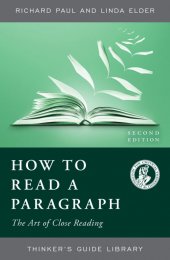How to Read a Paragraph: The Art of Close Reading
Second Edition
Richard Paul and Linda Elder
Contact Info for Bloomsbury:
- For questions about orders you have already placed, email weborders@mpsvirginia.com or telephone 888-330-8477, ext. 7527.
- For questions about eBook purchases or pre-orders, email contact@bloomsbury.com.
- For general enquiries not related to online orders, call 1 212-419-5300 or email contact@bloomsbury.com.
How to Read a Paragraph introduces the importance of purposeful skilled reading and lays out methods by which to develop close reading skills using the tools of critical thinking. Developing these skills enables students to read for deep understanding, to properly analyze and assess what they read, and to reason within the logic of an author. As readers engage with the thinking of authors and uncover their assumptions and motivations, they glean the most useful information from their written work.
This book pairs with How to Write a Paragraph to offer an in-depth introduction to effective reading and writing skills. Activities in the book help sharpen reading comprehension skills for an elevated level of self-understanding, fulfillment, and depth of vision.
As part of the Thinker’s Guide Library, this book advances the mission of the Foundation for Critical Thinking to promote fairminded critical societies through cultivating essential intellectual abilities and virtues across every field of study across world.
Pages: 60 • Trim: 6 x 8
978-0-944583-49-4 • Paperback • January 2014
978-1-5381-3382-8 • eBook • June 2019
Series:
Thinker's Guide Library
$25.20
Additional Information About:
How to Read a Paragraph: The Art of Close Reading
Skilled readers do not read blindly, but purposely. They have an agenda, goal, or objective. Their purpose, together with the nature of what they are reading, determines how they read. They read in different ways in different situations for different purposes. Of course, reading has a nearly universal purpose: to figure out what an author has to say on a given subject.
How you read should be determined in part by what you read. Reflective readers read a textbook, for example, using a different mindset than they use when reading an article in a newspaper. Furthermore, reflective readers read a textbook in biology differently from the way they read a textbook in history.
The reflective mind improves its thinking by reflectively thinking about it. Likewise, it improves its reading by reflectively thinking about how it is reading. It moves back and forth between the cognitive (thinking) and the metacognitive (thinking about thinking). It moves forward a bit, then loops back upon itself to check on its own operations. It checks its tracks. It makes good its ground. It rises above itself and exercises oversight on itself.
One of the most important abilities that a thinker can have is the ability to monitor and assess his or her own thinking while processing the thinking of others. In reading, the reflective mind monitors how it is reading while it is reading. The foundation for this ability is knowledge of how the mind functions when reading well.
Having recognized this, we should also recognize that there are core reading tools and skills for reading any substantive text. These tools and skills are the focus of this guide.
Contents include:
Theory
- The Premise of This Guide
- Reading for a Purpose
- Considering the Author’s Purpose
- Developing a “Map” of Knowledge
- Avoiding Impressionistic Reading and Writing
- Reading Reflectively
- Student Generated Map of Knowledge
- Faculty Generated Map of Knowledge
- Thinking About Reading While Reading
- Engaging a Text
- Books Are Teachers
- Reading Minds
- The Work of Reading
- Five Levels of Close Reading
- Structural Reading
- How to Read a Sentence
- How to Read a Paragraph
- How to Read a Textbook
- How to Read a Newspaper
- How to Read an Editorial
- Taking Ownership (Mark it Up)
- Reading to Learn
- Reading to Understand Systems of Thought
- Reading Within Disciplines
- The Art of Close Reading
Practice Exercises in Close Reading
- The Declaration of Independence by Thomas Jefferson et. al.
- Civil Disobedience by Henry David Thoreau
- The Nineteenth-Century American by Henry Steele Commager
- The Art of Loving by Erich Fromm
- Corn-Pone Opinions by Mark Twain
- The Revolt of the Masses by Jose Ortega y Gasset
- The True Believer by Eric Hoffer
- The Idea of Education by John Henry Newman
Appendices
A. Sample Paraphrases
B. Analyzing the Logic of an Article, Essay, or Chapter
C. Analyzing the Logic of a Textbook
D. The Logic of Ecology
